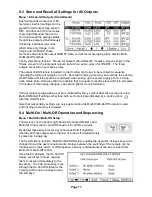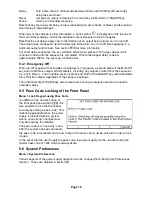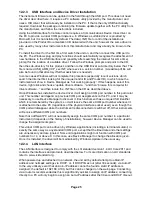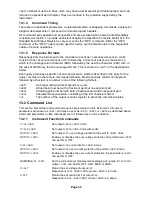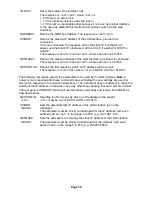
Page 29
Bit 7 -
Reserved for future use
Bit 6 - Set when a fault trip has occurred which requires AC power OFF/ON to reset.
Bit 5 - Reserved for future use
Bit 4 - Reserved for future use
Bit 3 - Set when an output over current trip has occurred
Bit 2 - Set when an output over voltage trip has occurred
Bit 1 - Set when output enters current limit (constant current mode)
Bit 0 -
Set when output enters voltage limit (constant voltage mode)
Standard Event Status Registers (ESR and ESE)
The Standard Event Status Register is defined by the IEEE Std. 488.2 GPIB standard. It is a bit
field, where each bit is independent and has the following significance:
Bit 7
Power On.
Set when power is first applied to the instrument.
Bits 6 & 1:
Not used, permanently 0.
Bit 5
Command Error.
Set when a syntax error is detected in a command or parameter.
The parser is reset and parsing continues at the next byte in the input stream.
Bit 4
Execution Error.
Set when a non-zero value is written to the Execution Error
register, if a syntactically correct command cannot be executed for any reason.
Bit 3
Verify Timeout Error.
Set when a parameter is set with 'verify' specified and the
value is not reached within 5 secs, e.g. output voltage is slowed by a large
capacitor on the output.
Bit 2
Query Error.
Set when a query error occurs, because the controller has not issued
commands and read response messages in the correct sequence.
Bit 0
Operation Complete.
Set in response to the ‘*OPC’ command.
The Standard Event Status Register is read and cleared by the *ESR? query, which returns a
decimal number corresponding to the contents. On power-up it is set to 128, to report the power
on bit.
The Standard Event Status Enable Register provides a mask between the Event Status
Register and the Status Byte Register. If any bit becomes ‘1’ in both registers, then the ESB bit
will be set in the Status Byte Register. This enable register is set by the *ESE <
NRF
> command
to a value 0 - 255, and read back by the *ESE? query (which will always return the value last
set by the controller). On power-up it is set to 0.
Execution Error Register (EER)
This instrument specific register contains a number representing the last command processing
error encountered over this interface. The error numbers have the following meaning:
0
No error has occurred since this register was last read.
100
Numeric Error:
the parameter value sent was outside the permitted range for the
command in the present circumstances.
102
Recall Error:
a
recall of set up data has been requested but the store specified does
not contain any data.
103
Command Invalid:
the command is recognised but is not valid in the current
circumstances. Typical examples would by trying to change V2 directly while the
outputs are in voltage tracking mode with V1 as the master.
Содержание MX180T
Страница 1: ...MX180T MX180TP Triple Output Multi Range DC Power Supply INSTRUCTION MANUAL ...
Страница 44: ......



